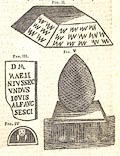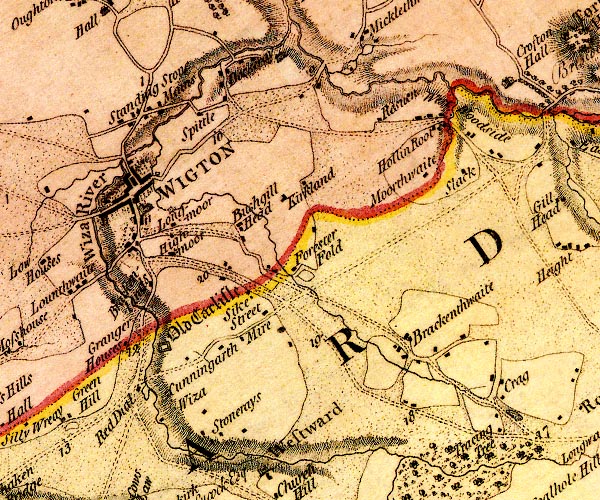




placename:- Cunningarth
placename:- Coning Garth
item:- roman finds; roman inscription
 goto source
goto sourceGentleman's Magazine 1748 p.179 "Mr URBAN,"
"I SEnd you some pieces of antiquity, which I lately discovered in the wall and adjoining houses of an obscure farm at Coning-garth, about 2 short miles southward from Wigton, in Cumberland, and not far from a large Roman encampment, called Old Carlisle, on the military way leading to Ellenborough."
"Old Carlisle has been variously understood by antiquaries; but Mr Horsley's opinion, that it was the Roman Olenacum, seems to have the greatest weight, where the Ala Herculea encamp'd at the time of the Notitia."
 click to enlarge
click to enlargeG748E05.jpg
"FIG. I. is a Triton; the stone is about 21/2foot by 16 inches; whether there has been any figure on the other sides cannot be learn'd, as 'tis built in the wall; it is in full demi-relievo, and tolerably well executed, at least much better than many sculptures of those times, but 'tis imperfect; below the tail has been another figure, but the stone is broke off; and, facing the Triton a third also defac'd and imperfect."
 click to enlarge
click to enlargeG748E06.jpg
"FIG. II. is the corner stone of a stable, or barn, at the very foundation, probably a pedestal to a funeral monument. The figures on it resemble scales, or waves, and whether it has been a plinth for the Triton, and the whole a sepulchral pillar, is not now to be determin'd."
"FIG III. is an inscription, now placed horizontally, as the upper lintel of a window near the Triton, by which it seems probable that the Ala Augusta had some time garrison'd this place; it is of the funeral kind, and dedicated to the Dis Manibus. I hope the curious will oblige us with their reading and interpretation of it."
"FIG. IV. is a view of a stone, which I take to be the capital of the whole monument; the length of the plinth is 171/2inches, breadth 12, height 7 inches, of which 2 are edg'd away in a slope moulding, and the spheroid on the plinth is 20 inches"
 goto source
goto sourceGentleman's Magazine 1748 p.180 "high, 14 inches diameter one way, and 12 the other, exactly equal to the breadth of the base, and wrought over with a kind of net-work, probably taken from the cone of a fir-apple. Its most singular curiosity is, that plinth and spheroid make but one entire stone, contrary to the custom of the moderns spiking their globes. I am persuaded if the whole funeral obelisk had been entire, it would have been one of the most curious of the kind yet discovered. At present it lies in a back yard, useless and disregarded."
"Yours, &c. G.S."
"... ..."
placename:- Cunningarth

D4NY24NE.jpg
"Cunningarth"
block or blocks, labelled in lowercase; a hamlet or just a house
item:- Carlisle Library : Map 2
Image © Carlisle Library
